Toward a Simple and Generic Approach for Identifying Multi-Year Cotton Cropping Patterns Using Landsat and Sentinel-2 Time Series
Abstract
:1. Introduction
2. Materials and Methods
2.1. Study Area
2.2. Landsat and Sentinel Image Collection and Preprocessing
2.3. Training and Validation Samples
2.4. Methods
2.4.1. Annual Crop Phenological Pattern Identification
2.4.2. Training Samples for Multi-Year Cotton-Cropping Patterns
2.4.3. Random Forest Classification
2.4.4. Classification Accuracy Assessment
3. Results
3.1. Intra-Annual Cotton Mapping Based on the RF Method
3.2. Multi-Year Cotton Cropping Pattern Identification
3.3. GIS-Driven Multi-Year Cotton Cropping Pattern Extraction
4. Discussion
4.1. Accuracy of Cotton Cropping Pattern Identification
4.2. Advantage and Versatility of the Proposed Simple and Generic Approach
4.3. Implications for Precise Farmland Management
5. Conclusions
Author Contributions
Funding
Institutional Review Board Statement
Informed Consent Statement
Data Availability Statement
Acknowledgments
Conflicts of Interest
References
- United Nations. World Population Prospects: The 2017 Revision, Key Findings and Advance Tables; Working Paper No. ESA/P/WP/248; United Nations: New York, NY, USA, 2017. [Google Scholar]
- Karthikeyan, L.; Chawla, I.; Mishra, A.K. A review of remote sensing applications in agriculture for food security: Crop growth and yield, irrigation, and crop losses. J. Hydrol. 2020, 586, 124905. [Google Scholar] [CrossRef]
- United Nations. Transforming Our World, the 2030 Agenda for Sustainable Development; United Nations: New York, NY, USA, 2015; Available online: https://stg-wedocs.unep.org/bitstream/handle/20.500.11822/11125/unepswiosm1inf7sdg.pdf?sequence=1 (accessed on 11 November 2021).
- Bargiel, D. A new method for crop classification combining time series of radar images and crop phenology information. Remote Sens. Environ. 2017, 198, 369–383. [Google Scholar] [CrossRef]
- Elhassan, T.; Aljurf, M.; Al-Mohanna, F.; Shoukri, M. Classification of imbalance data using tomek link (t-link) combined with random under-sampling (RUS) as a data reduction method. Glob. J. Technol. Optim. 2017, S1, 111. [Google Scholar] [CrossRef]
- Matton, N.; Canto, G.S.; Waldner, F.; Valero, S.; Morin, D.; Inglada, J.; Arias, M.; Bontemps, S.; Koetz, B.; Defourny, P. An automated method for annual cropland mapping along the season for various globally-distributed agrosystems using high spatial and temporal resolution time series. Remote Sens. 2015, 7, 13208–13232. [Google Scholar] [CrossRef] [Green Version]
- Chen, Y.; Lu, D.; Moran, E.; Batistella, M.; Dutra, L.V.; Sanches, I.D.A.; da Silva, R.F.B.; Huang, J.; Luiz, A.J.B.; de Oliveira, M.A.F. Mapping croplands, cropping patterns, and crop types using MODIS time-series data. Int. J. Appl. Earth Obs. Geoinf. 2018, 69, 133–147. [Google Scholar] [CrossRef]
- Coppin, P.; Jonckheere, I.; Nackaerts, K.; Muys, B.; Lambin, E. Digital change detection methods in ecosystem monitoring: A review. Int. J. Remote Sens. 2004, 25, 1565–1596. [Google Scholar] [CrossRef]
- Hussain, M.; Chen, D.; Cheng, A.; Wei, H.; Stanley, D. Change detection from remotely sensed images: From pixel-based to object-based approaches. ISPRS J. Photogramm. Remote Sens. 2013, 80, 91–106. [Google Scholar] [CrossRef]
- Stern, A.; Doraiswamy, P.C.; Hunt, E.R., Jr. Changes of crop rotation in Iowa determined from the United States Department of Agriculture, National Agricultural Statistics Service cropland data layer product. J. Appl. Remote Sens. 2012, 6, 63590. [Google Scholar] [CrossRef]
- Martínez-Casasnovas, J.A.; Martín-Montero, A.; Casterad, M.A. Mapping multi-year cropping patterns in small irrigation districts from time-series analysis of Landsat TM images. Eur. J. Agron. 2005, 23, 159–169. [Google Scholar] [CrossRef]
- Sianturi, R.; Jetten, V.G.; Sartohadi, J. Mapping cropping patterns in irrigated rice fields in West Java: Towards mapping vulnerability to flooding using time-series MODIS imageries. Int. J. Appl. Earth Obs. Geoinf. 2018, 66, 1–13. [Google Scholar] [CrossRef]
- Mariotto, I.; Thenkabail, P.S.; Huete, A.; Slonecker, E.T.; Platonov, A. Hyperspectral versus multispectral crop-productivity modeling and type discrimination for the HyspIRI mission. Remote Sens. Environ. 2013, 139, 291–305. [Google Scholar] [CrossRef]
- Zheng, B.; Myint, S.W.; Thenkabail, P.S.; Aggarwal, R.M. A support vector machine to identify irrigated crop types using time-series Landsat NDVI data. Int. J. Appl. Earth Obs. Geoinf. 2015, 34, 103–112. [Google Scholar] [CrossRef]
- Bégué, A.; Arvor, D.; Bellon, B.; Betbeder, J.; De Abelleyra, D.; PD Ferraz, R.; Lebourgeois, V.; Lelong, C.; Simões, M.; Verón, S.R. Remote sensing and cropping practices: A review. Remote Sens. 2018, 10, 99. [Google Scholar] [CrossRef] [Green Version]
- Muhammad, S.; Zhan, Y.; Wang, L.; Hao, P.; Niu, Z. Major crops classification using time series MODIS EVI with adjacent years of ground reference data in the US State of Kansas. Optik 2016, 127, 1071–1077. [Google Scholar] [CrossRef]
- Zhong, L.; Hu, L.; Zhou, H. Deep learning based multi-temporal crop classification. Remote Sens. Environ. 2019, 221, 430–443. [Google Scholar] [CrossRef]
- Kobayashi, N.; Tani, H.; Wang, X.; Sonobe, R. Crop classification using spectral indices derived from Sentinel-2A imagery. J. Inf. Telecommun. 2020, 4, 67–90. [Google Scholar] [CrossRef]
- Zhang, X.; Sun, Y.; Shang, K.; Zhang, L.; Wang, S. Crop classification based on feature band set construction and object-oriented approach using hyperspectral images. IEEE J. Sel. Top. Appl. Earth Obs. Remote Sens. 2016, 9, 4117–4128. [Google Scholar] [CrossRef]
- Gómez, C.; White, J.C.; Wulder, M.A. Optical remotely sensed time series data for land cover classification: A review. ISPRS J. Photogramm. Remote Sens. 2016, 116, 55–72. [Google Scholar] [CrossRef] [Green Version]
- Long, J.A.; Lawrence, R.L.; Greenwood, M.C.; Marshall, L.; Miller, P.R. Object-oriented crop classification using multitemporal ETM+ SLC-off imagery and random forest. GIScience Remote Sens. 2013, 50, 418–436. [Google Scholar] [CrossRef]
- Li, Z.; Gang, Z.; Zhang, T. Interleaved group convolutions for multitemporal multisensor crop classification. Infrared Phys. Technol. 2019, 102, 103023. [Google Scholar] [CrossRef]
- Belgiu, M.; Csillik, O. Sentinel-2 cropland mapping using pixel-based and object-based time-weighted dynamic time warping analysis. Remote Sens. Environ. 2018, 204, 509–523. [Google Scholar] [CrossRef]
- Tong, X.; Brandt, M.; Hiernaux, P.; Herrmann, S.M.; Tian, F.; Prishchepov, A.V.; Fensholt, R. Revisiting the coupling between NDVI trends and cropland changes in the Sahel drylands: A case study in western Niger. Remote Sens. Environ. 2017, 191, 286–296. [Google Scholar] [CrossRef] [Green Version]
- Zhang, M.; Zhou, Q.; Chen, Z.; Liu, J.; Zhou, Y.; Cai, C. Crop discrimination in Northern China with double cropping systems using Fourier analysis of time-series MODIS data. Int. J. Appl. Earth Obs. Geoinf. 2008, 10, 476–485. [Google Scholar] [CrossRef]
- Qiu, B.; Zhong, M.; Tang, Z.; Wang, C. A new methodology to map double-cropping croplands based on continuous wavelet transform. Int. J. Appl. Earth Obs. Geoinf. 2014, 26, 97–104. [Google Scholar] [CrossRef]
- Liu, Z.; Gao, J.; Gao, F.; Dong, S.; Liu, P.; Zhao, B.; Zhang, J. Integrated agronomic practices management improve yield and nitrogen balance in double cropping of winter wheat-summer maize. Field Crop. Res. 2018, 221, 196–206. [Google Scholar] [CrossRef]
- Petitjean, F.; Inglada, J.; Gançarski, P. Satellite image time series analysis under time warping. IEEE Trans. Geosci. Remote Sens. 2012, 50, 3081–3095. [Google Scholar] [CrossRef]
- Tuia, D.; Volpi, M.; Copa, L.; Kanevski, M.; Munoz-Mari, J. A survey of active learning algorithms for supervised remote sensing image classification. IEEE J. Sel. Top. Signal Process. 2011, 5, 606–617. [Google Scholar] [CrossRef]
- Li, C.; Wang, J.; Wang, L.; Hu, L.; Gong, P. Comparison of classification algorithms and training sample sizes in urban land classification with Landsat thematic mapper imagery. Remote Sens. 2014, 6, 964–983. [Google Scholar] [CrossRef] [Green Version]
- Gong, L.; He, G.; Liu, W. Long-term cropping effects on agricultural sustainability in Alar oasis of Xinjiang, China. Sustainability 2016, 8, 61. [Google Scholar] [CrossRef] [Green Version]
- Fan, Y.; Chen, Y.; Liu, Y.; Li, W. Variation of baseflows in the headstreams of the Tarim River Basin during 1960–2007. J. Hydrol. 2013, 487, 98–108. [Google Scholar] [CrossRef]
- Zhao, R.; Chen, Y.; Shi, P.; Zhang, L.; Pan, J.; Zhao, H. Land use and land cover change and driving mechanism in the arid inland river basin: A case study of Tarim River, Xinjiang, China. Environ. Earth Sci. 2013, 68, 591–604. [Google Scholar] [CrossRef]
- Nhu, V.-H.; Mohammadi, A.; Shahabi, H.; Shirzadi, A.; Al-Ansari, N.; Ahmad, B.B.; Chen, W.; Khodadadi, M.; Ahmadi, M.; Khosravi, K.; et al. Monitoring and Assessment of Water Level Fluctuations of the Lake Urmia and Its Environmental Consequences Using Multitemporal Landsat 7 ETM+ Images. Int. J. Environ. Res. Public Health 2020, 17, 4210. [Google Scholar] [CrossRef]
- Liu, H.Q.; Huete, A. A feedback based modification of the NDVI to minimize canopy background and atmospheric noise. IEEE Trans. Geosci. Remote Sens. 1995, 33, 457–465. [Google Scholar] [CrossRef]
- Savitzky, A.; Golay, M.J. Smoothing and differentiation of data by simplified least squares procedures. Anal. Chem. 1964, 36, 1627–1639. [Google Scholar] [CrossRef]
- Breiman, L. Random forests. Mach. Learn. 2001, 45, 5–32. [Google Scholar] [CrossRef] [Green Version]
- Karasiak, N.; Perbet, P. Remote sensing of distinctive vegetation in Guiana amazonian park. QGIS Appl. Agric. For. 2018, 2, 215–245. [Google Scholar]
- Debats, S.R.; Luo, D.; Estes, L.D.; Fuchs, T.J.; Caylor, K.K. A generalized computer vision approach to mapping crop fields in heterogeneous agricultural landscapes. Remote Sens. Environ. 2016, 179, 210–221. [Google Scholar] [CrossRef] [Green Version]
- Ghimire, B.; Rogan, J.; Miller, J. Contextual land-cover classification: Incorporating spatial dependence in land-cover classification models using random forests and the Getis statistic. Remote Sens. Lett. 2010, 1, 45–54. [Google Scholar] [CrossRef] [Green Version]
- Lawrence, R.L.; Wood, S.D.; Sheley, R.L. Mapping invasive plants using hyperspectral imagery and Breiman Cutler classifications (RandomForest). Remote Sens. Environ. 2006, 100, 356–362. [Google Scholar] [CrossRef]
- Xian, Y.; Lu, Y.; Musyimi, Z.; Liu, G. Tracking the Role of Policies and Economic Factors in Driving the Forest Change Trajectories within the Guangdong-Hongkong-Macao Region of China: A Remote Sensing Perspective. Land 2021, 10, 87. [Google Scholar] [CrossRef]
- Liu, G.; Zhang, L.; You, H. Spatiotemporal dynamics of arable land in the Nanjing metropolitan region, China. Environ. Earth Sci. 2015, 73, 7183–7191. [Google Scholar] [CrossRef]
- Liu, G.; Kurban, A.; Halik, U.; Duan, H.; Gartner, P.; Kleinschmit, B.; Ablekim, A.; Niu, T. Analysis of vegetation landscape pattern dynamics based on trajectory change detection: A case study of ecological water transportation in the lower reaches of Tarim River. J. Desert Res. 2012, 32, 1472–1478. [Google Scholar]
- Schneibel, A.; Stellmes, M.; Röder, A.; Frantz, D.; Kowalski, B.; Haß, E.; Hill, J. Assessment of spatio-temporal changes of smallholder cultivation patterns in the Angolan Miombo belt using segmentation of Landsat time series. Remote Sens. Environ. 2017, 195, 118–129. [Google Scholar] [CrossRef] [Green Version]
- Conrad, C.; Lamers, J.P.A.; Ibragimov, N.; Löw, F.; Martius, C. Analysing irrigated crop rotation patterns in arid Uzbekistan by the means of remote sensing: A case study on post-Soviet agricultural land use. J. Arid. Environ. 2016, 124, 150–159. [Google Scholar] [CrossRef]
- Ju, X.; Liu, X.; Zhang, F.; Roelcke, M. Nitrogen fertilization, soil nitrate accumulation, and policy recommendations in several agricultural regions of China. AMBIO A J. Hum. Environ. 2004, 33, 300–305. [Google Scholar] [CrossRef]
- Dias, T.; Dukes, A.; Antunes, P.M. Accounting for soil biotic effects on soil health and crop productivity in the design of crop rotations. J. Sci. Food Agric. 2015, 95, 447–454. [Google Scholar] [CrossRef]
- Wright, D.L.; Marois, J.J.; Wiatrak, P.J.; Katsvairo, T.W. Sodbased rotations for cotton/peanut in the southeast US. In Proceedings of the 2005 Beltwide Cotton Conferences, New Orleans, LA, USA, 4–7 January 2005. [Google Scholar]
- Kahlown, M.A.; Raza, Z.I.; Hanif, M. Crop Rotations to Reclaim Abandoned Soils. Pak. J. Water Resour. 2003, 7, 65. [Google Scholar]
- Kienzler, K.M. Improving the nitrogen use efficiency and crop quality in the Khorezm region, Uzbekistan. Ph.D. Thesis, Rheinische Friedrich-Wilhelms-Universität Bonn, Bonn, Germany, 2010. [Google Scholar]
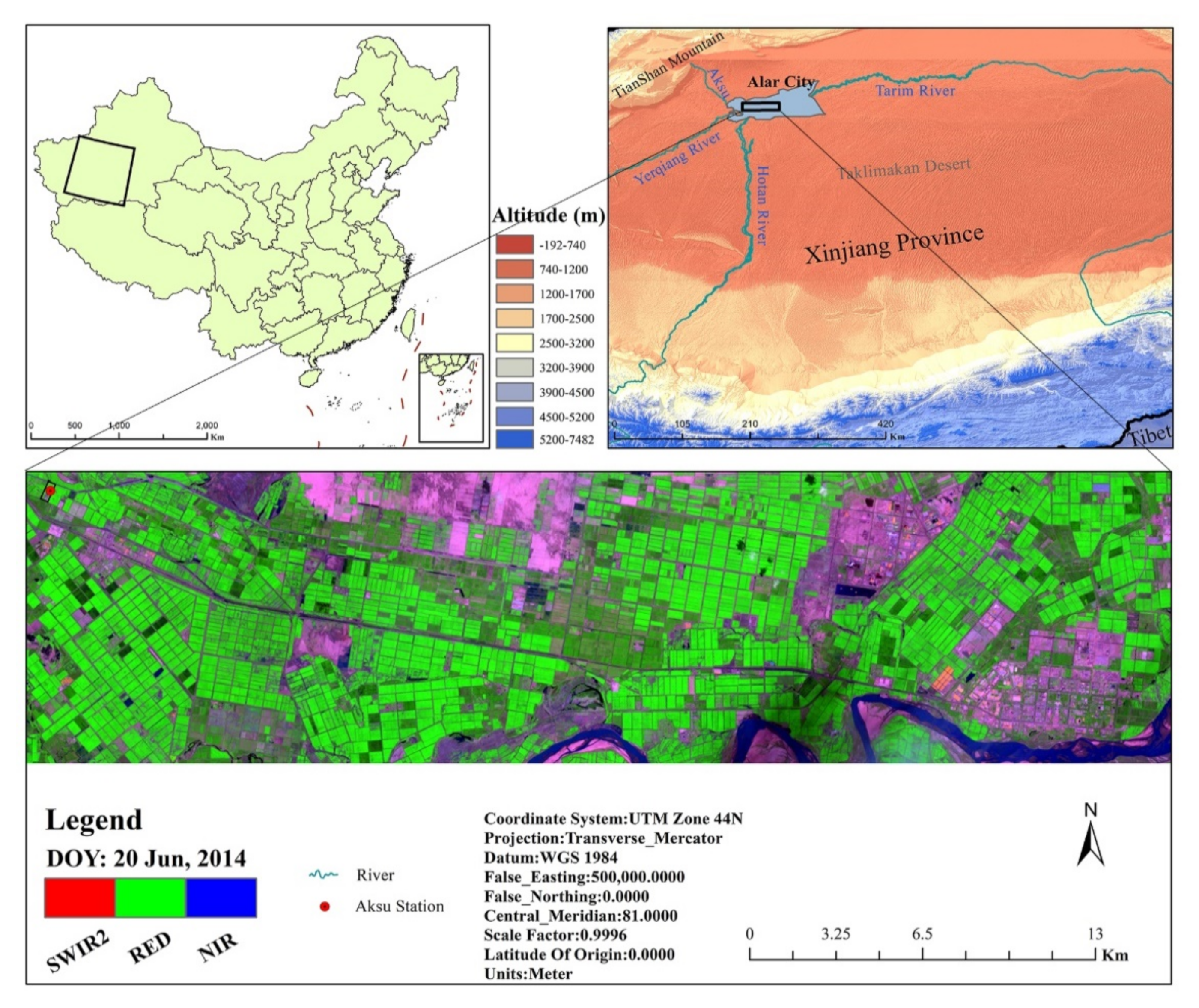
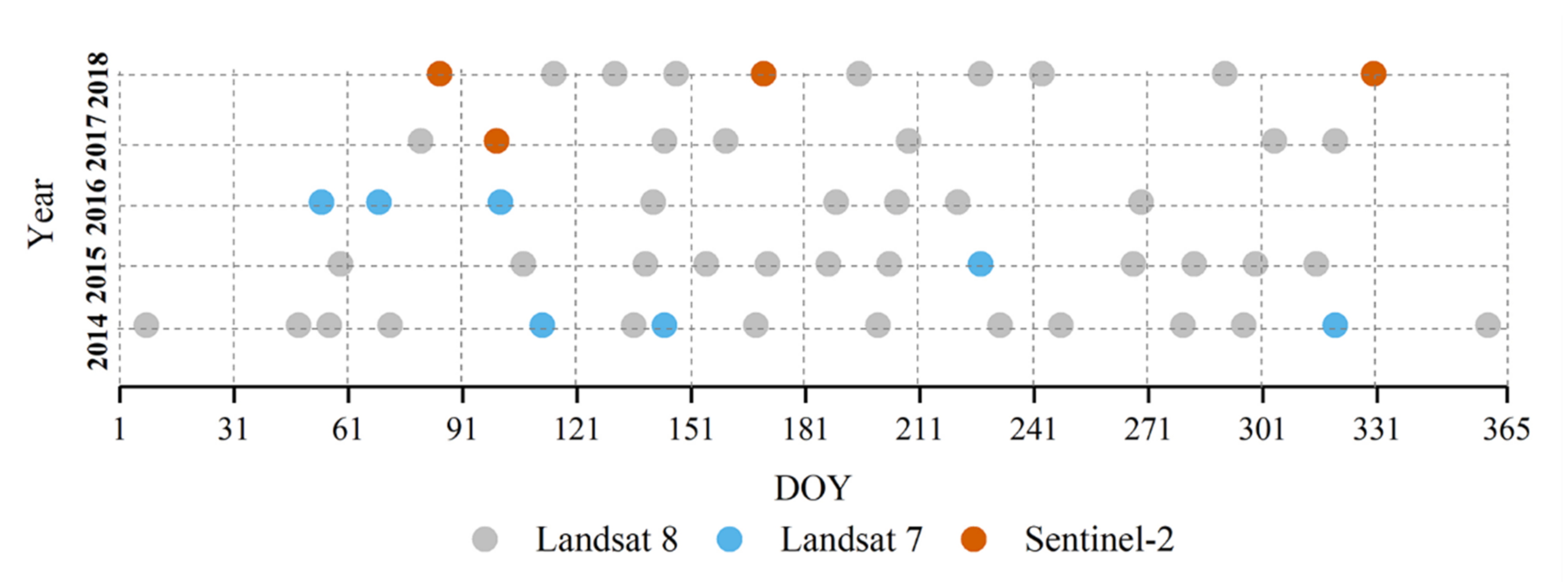
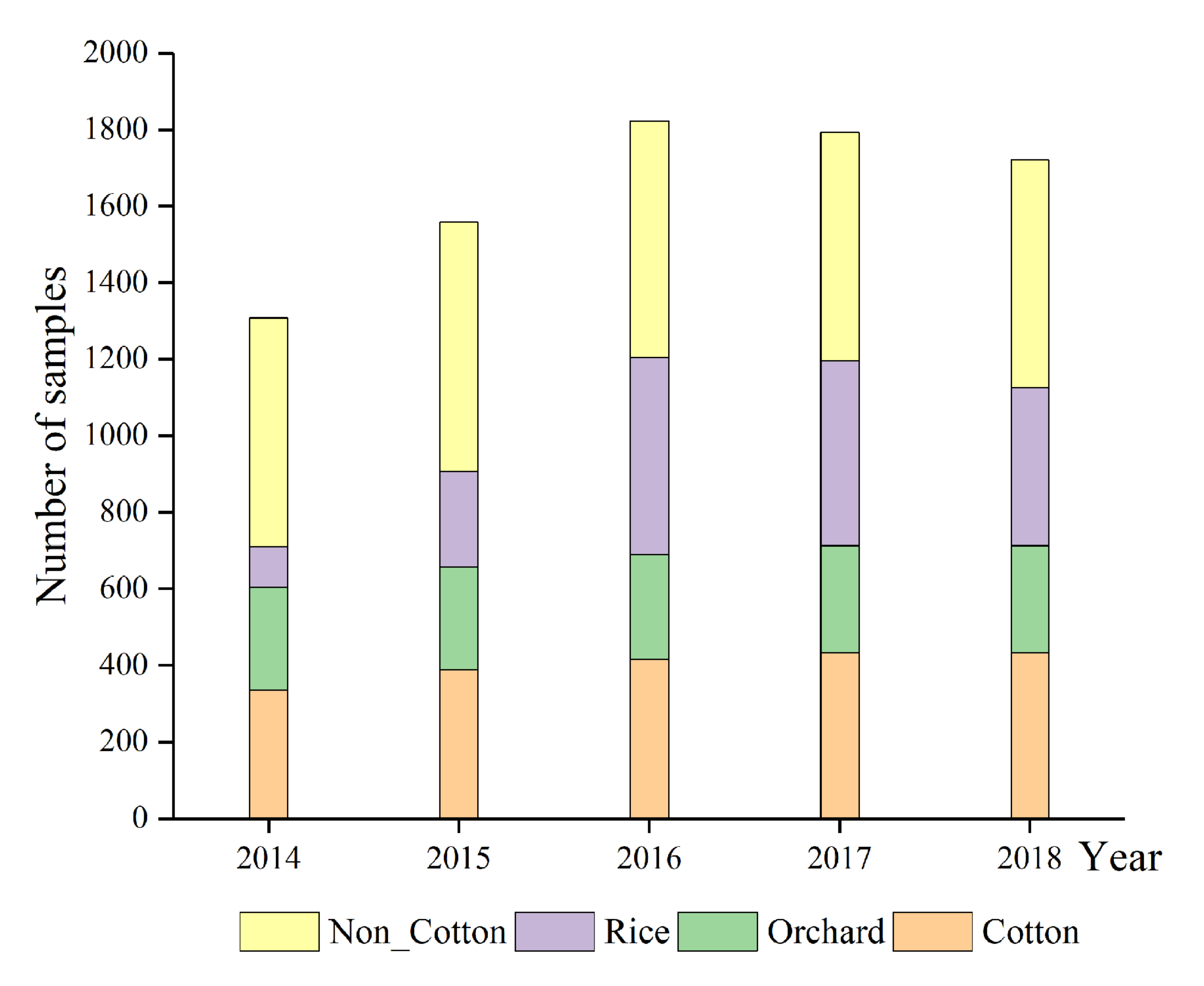
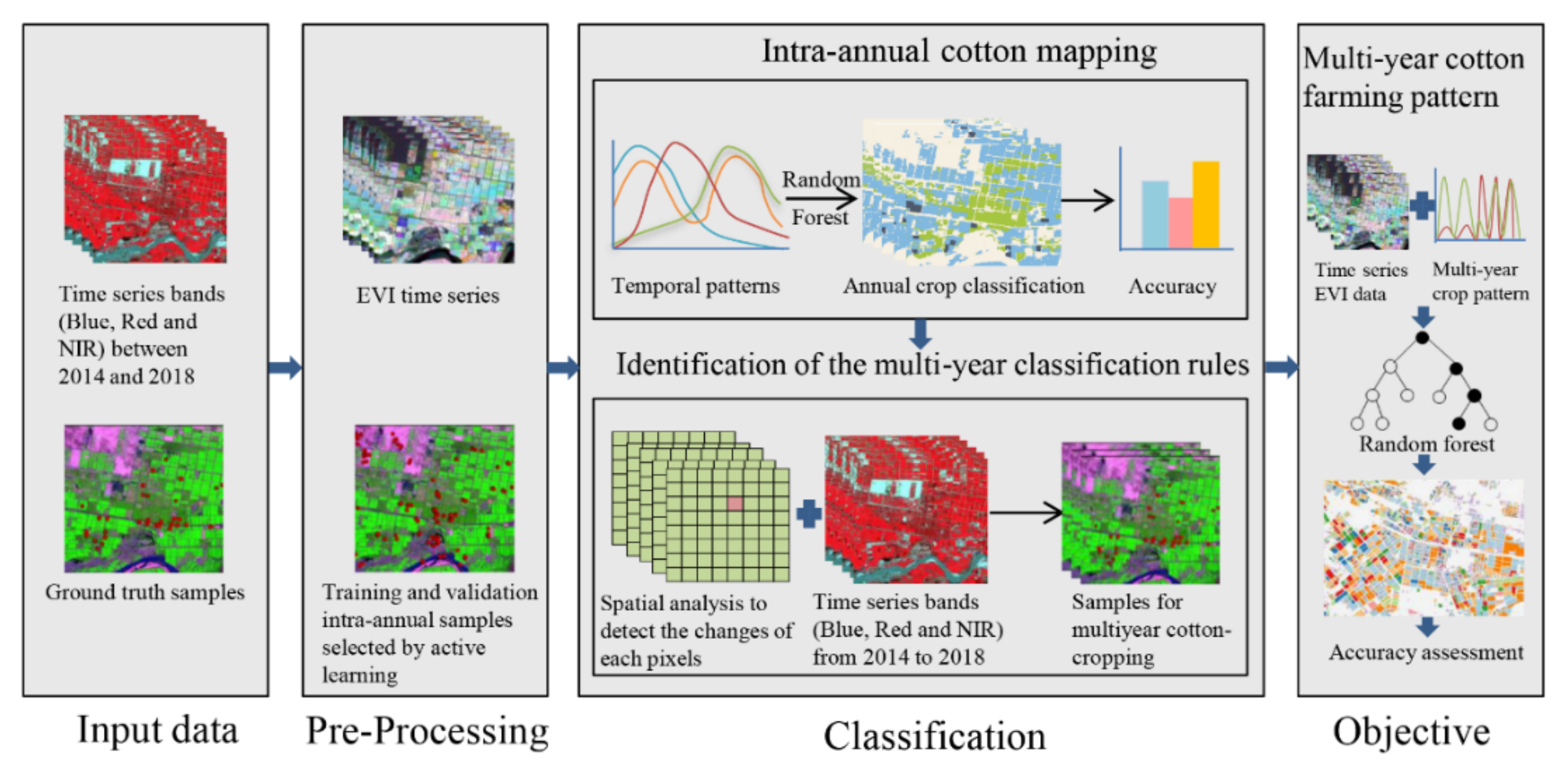

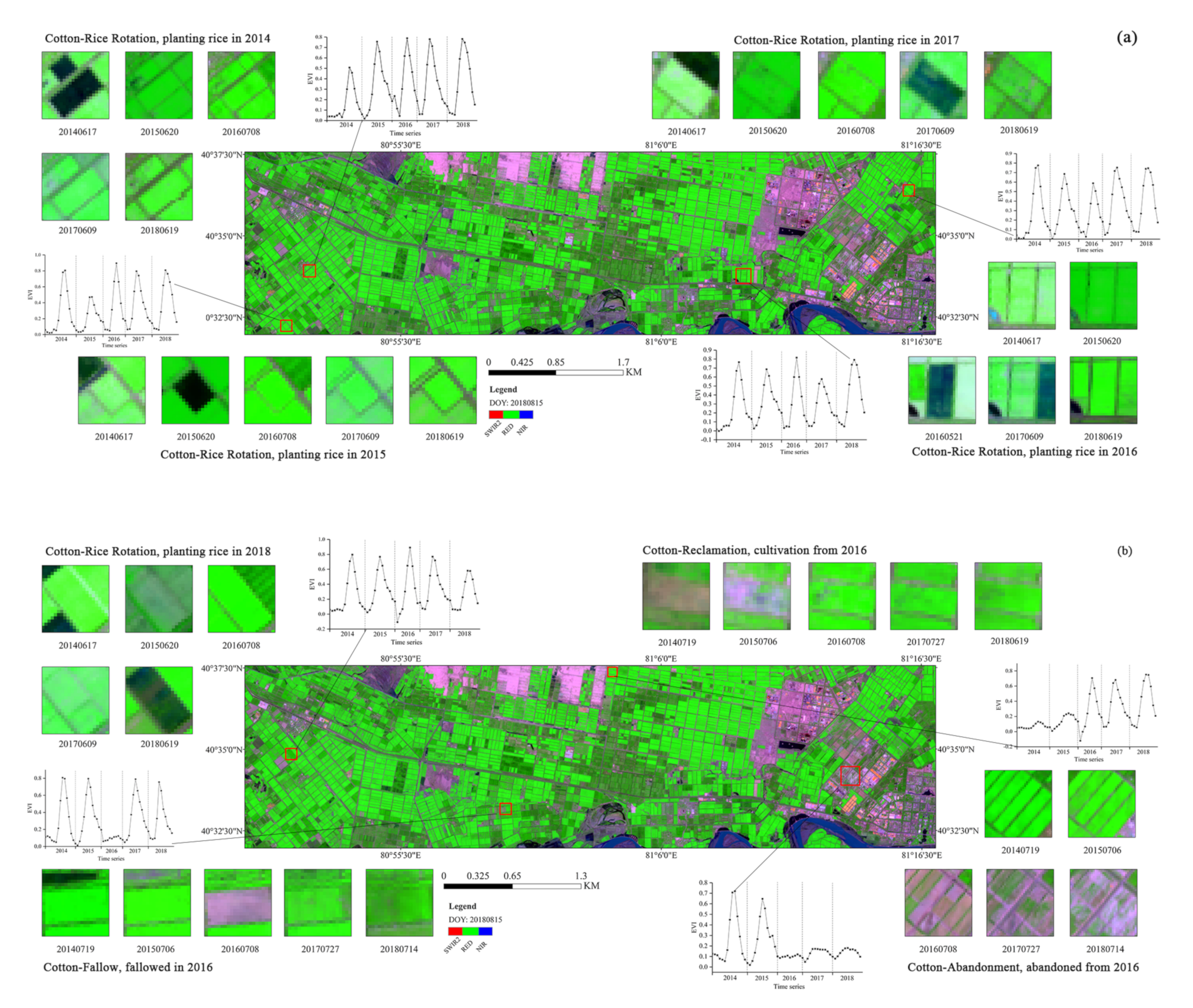

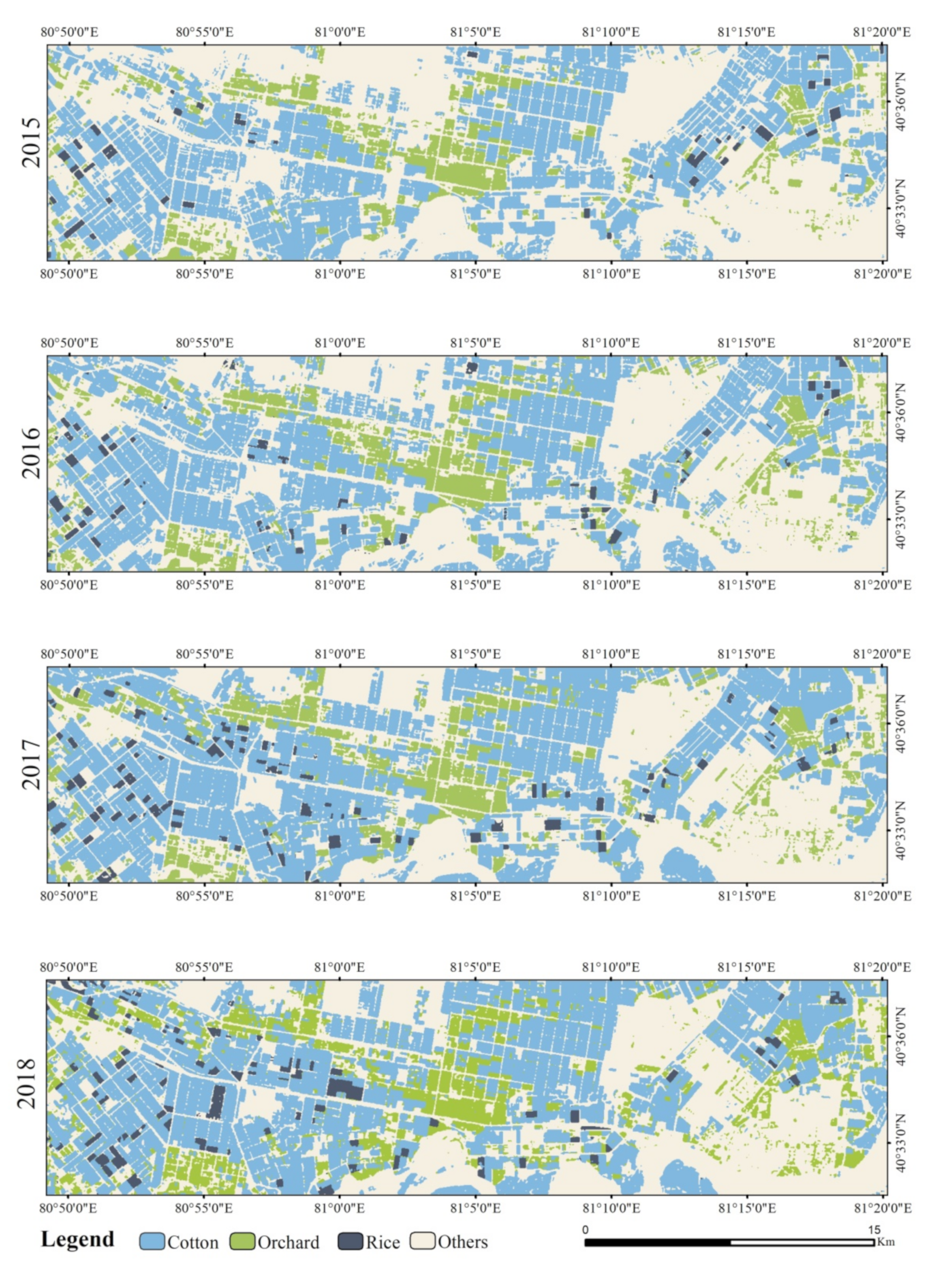
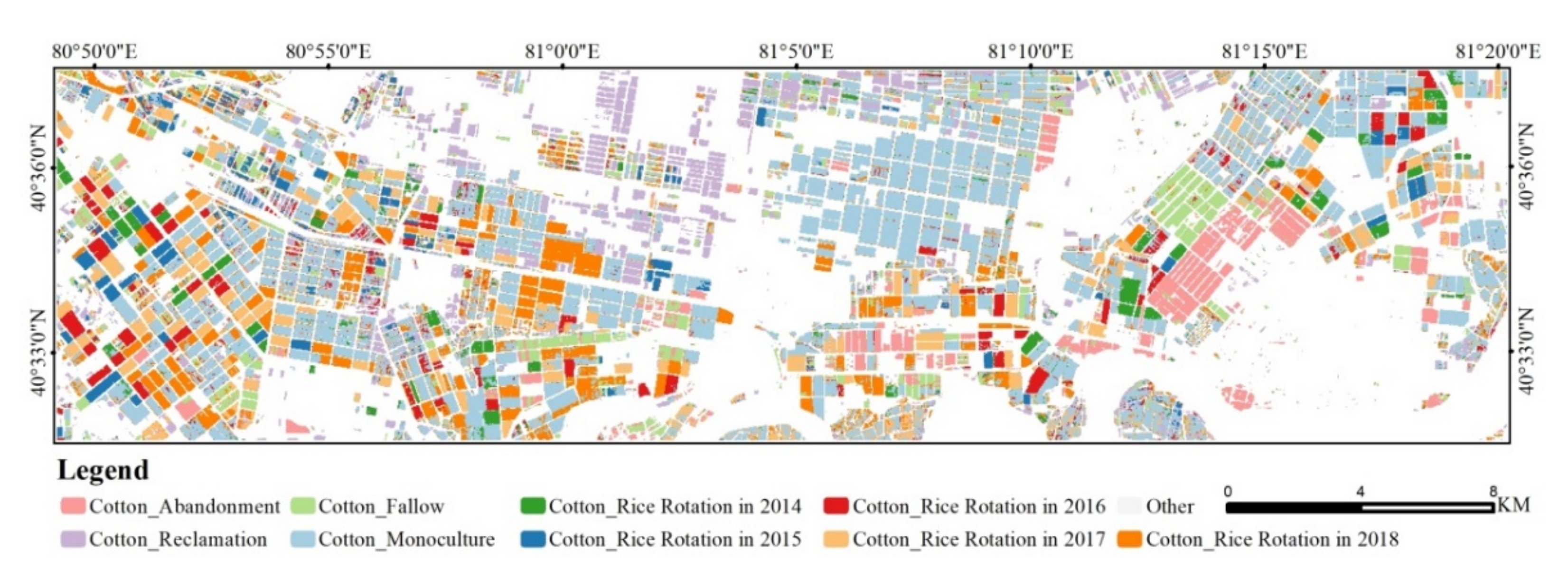
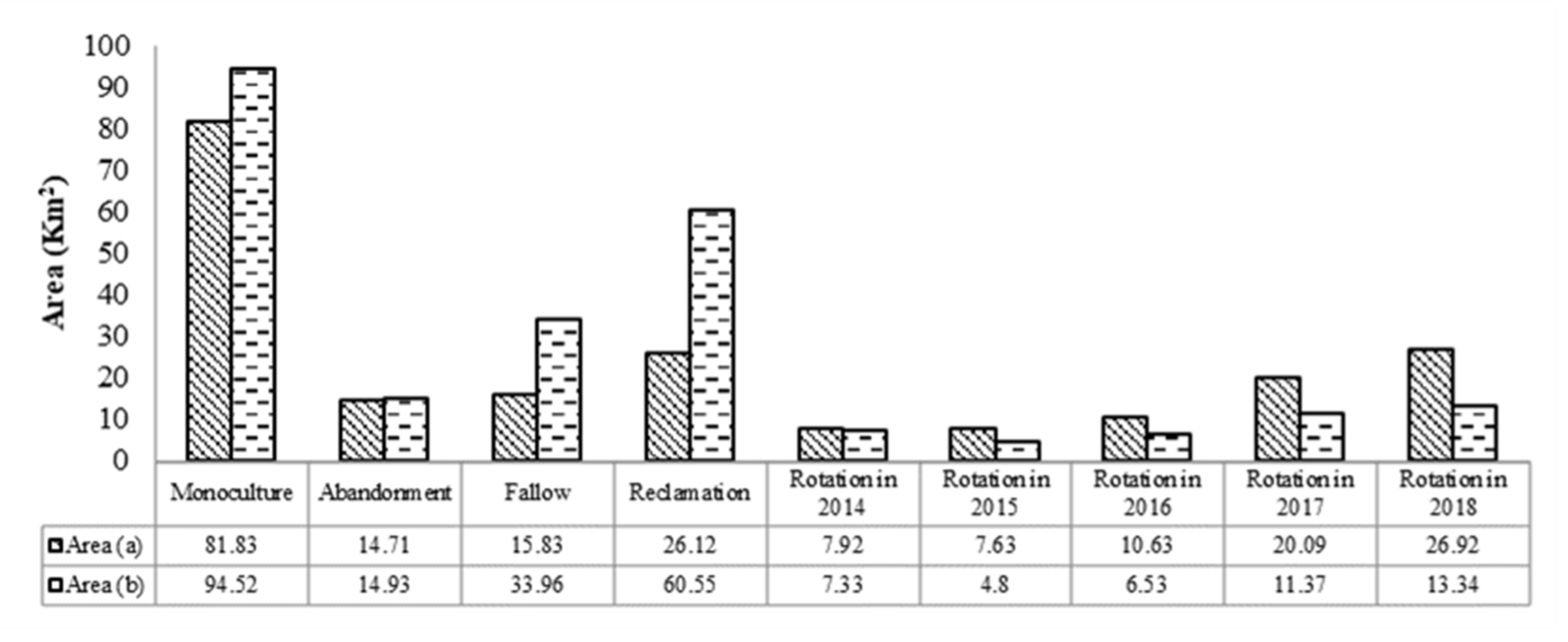

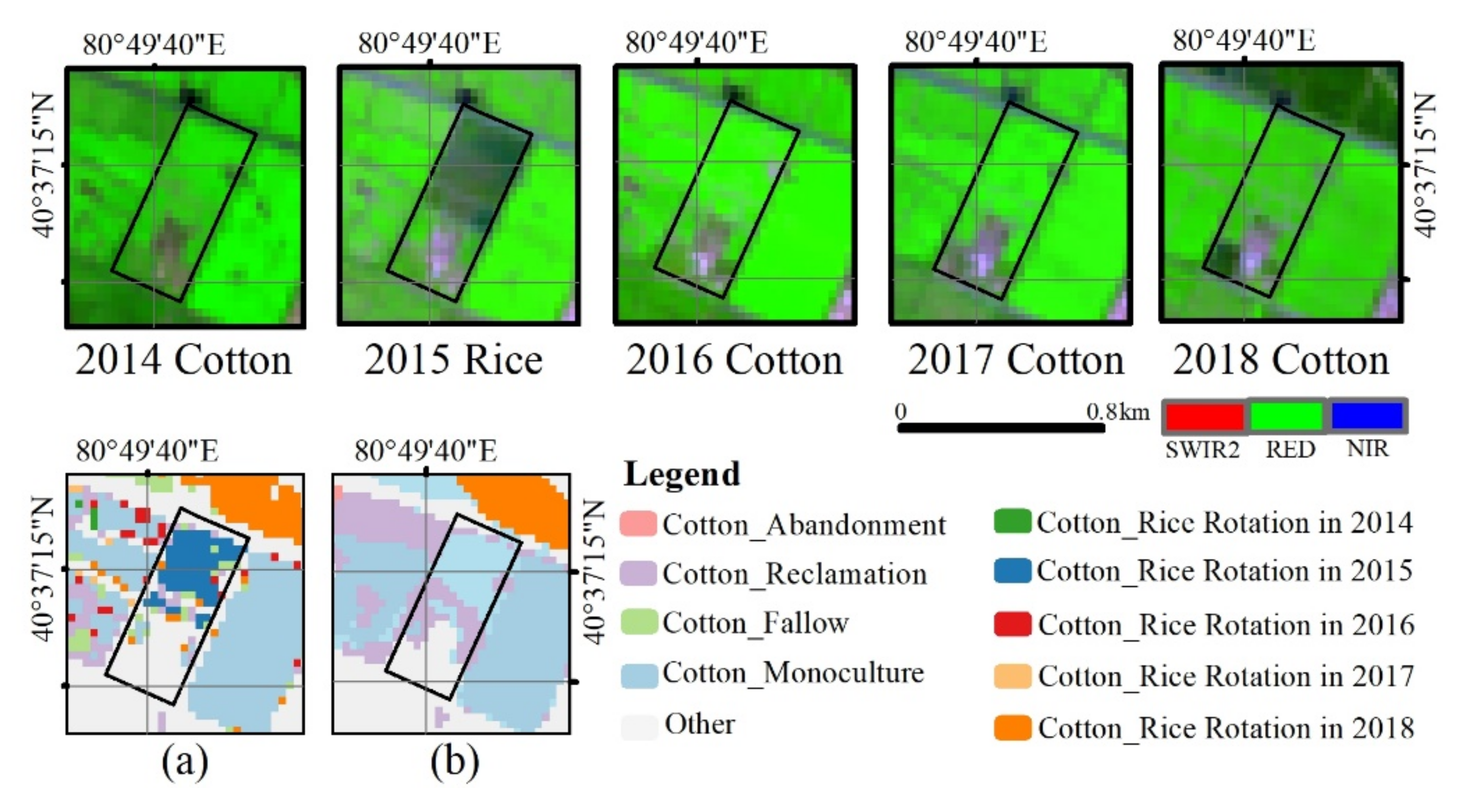
| Multi-Year Cotton-Farming Patterns | Definition of Rules | Temporal Phenological Patterns |
|---|---|---|
| Monoculture | Cotton was planted over five consecutive years in a particular field. This process was referred to as continuous cotton cropping. |  |
| Abandonment | Farmers stop growing cotton and other crops for more than two consecutive years. | 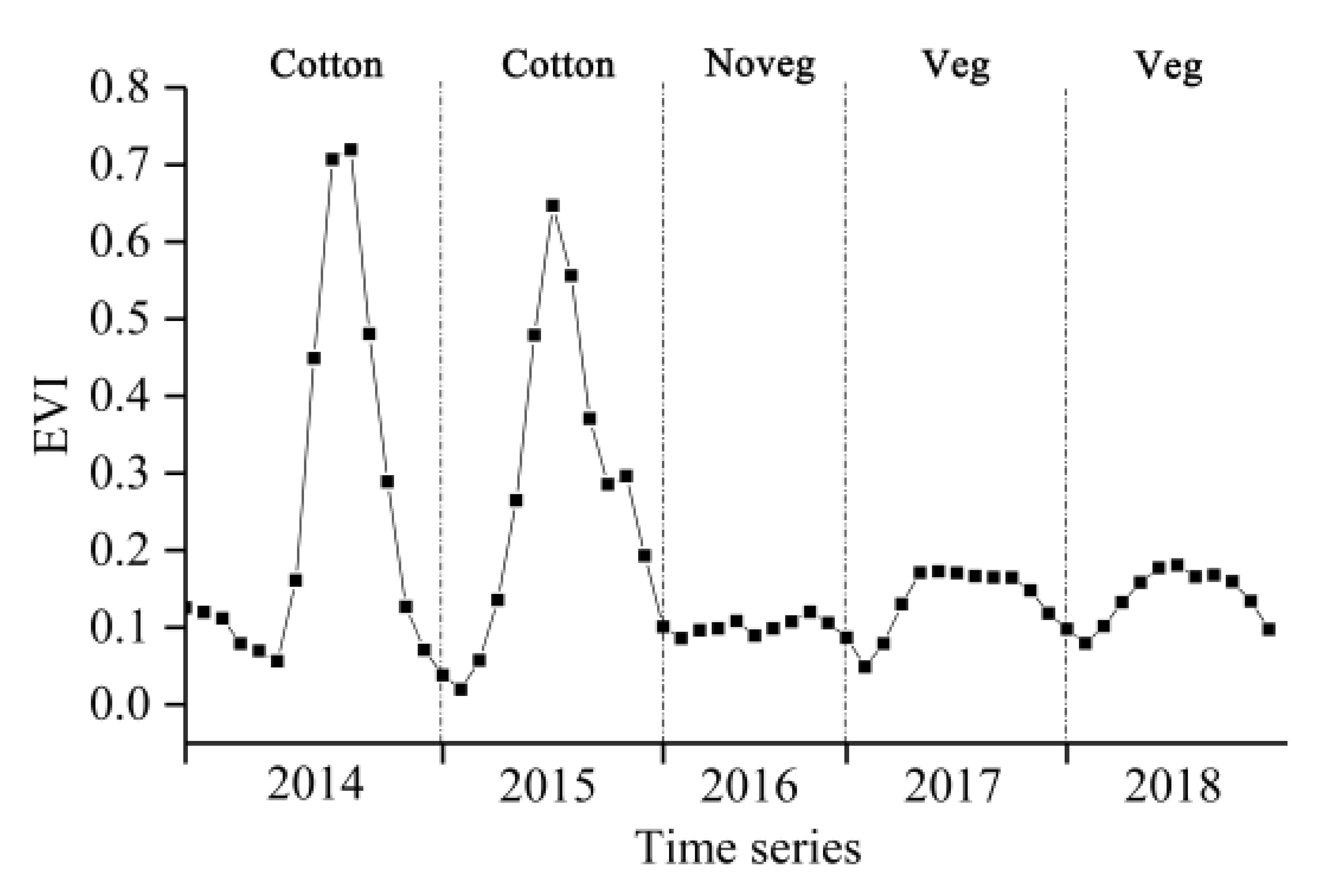 |
| Fallow | Cotton-farmed area rotation with bare land in a given year for no more than one year. | 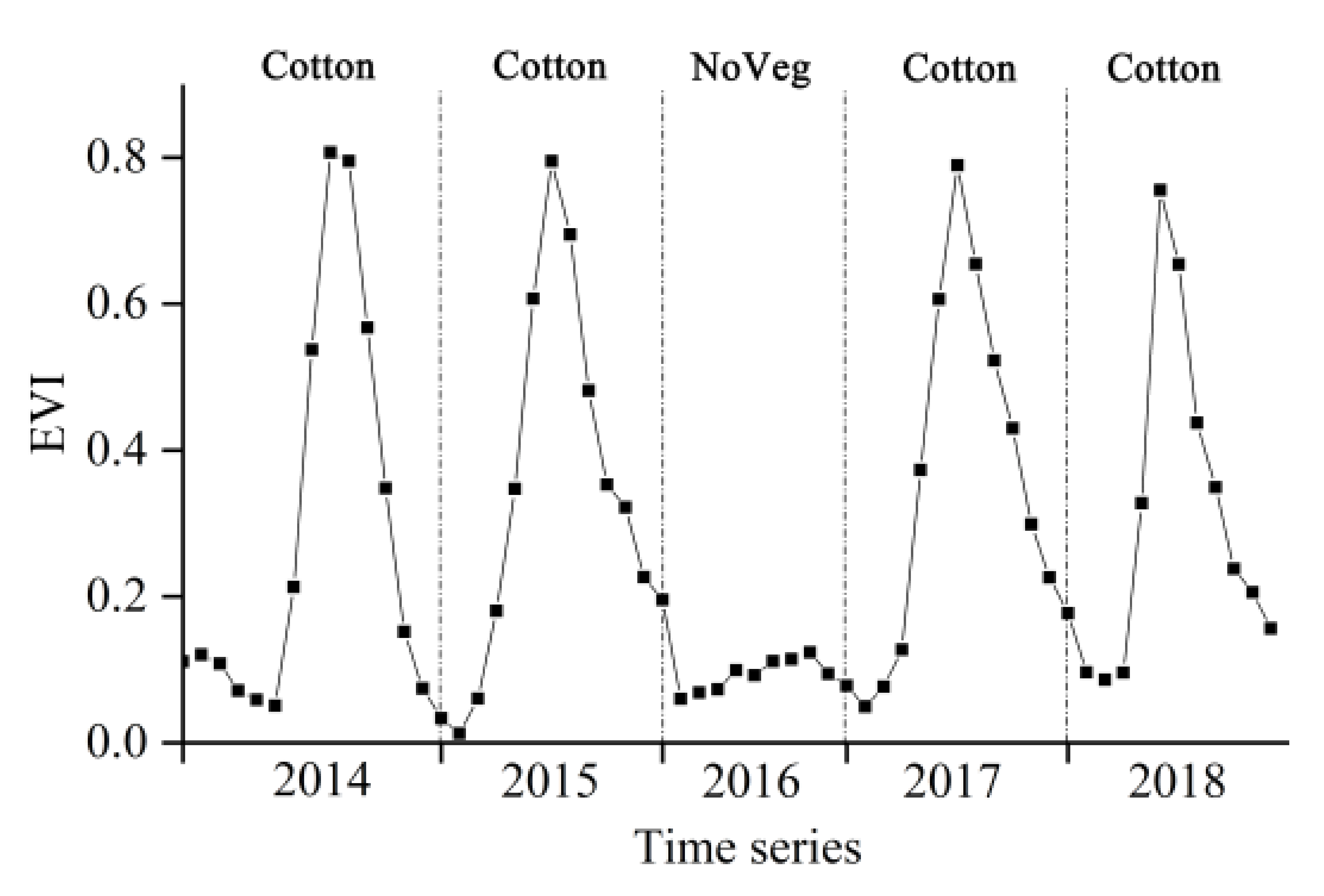 |
| Reclamation | Certain crop fields were changed from other land-use classes to cotton. | 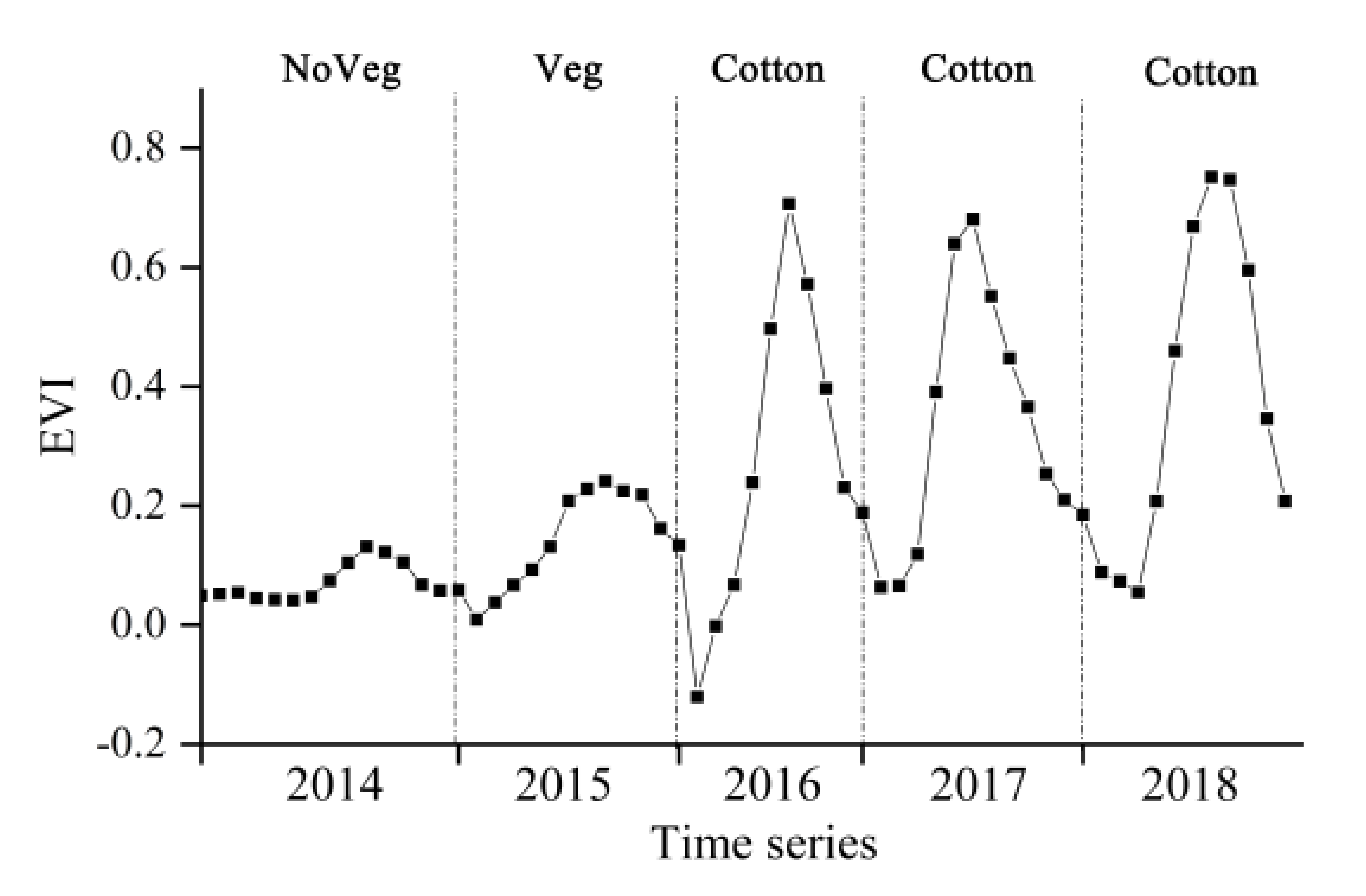 |
| Cotton-rice rotation | Rotating cotton with rice in a given year with the aim to enable regeneration of soil fertility. |  |
 | ||
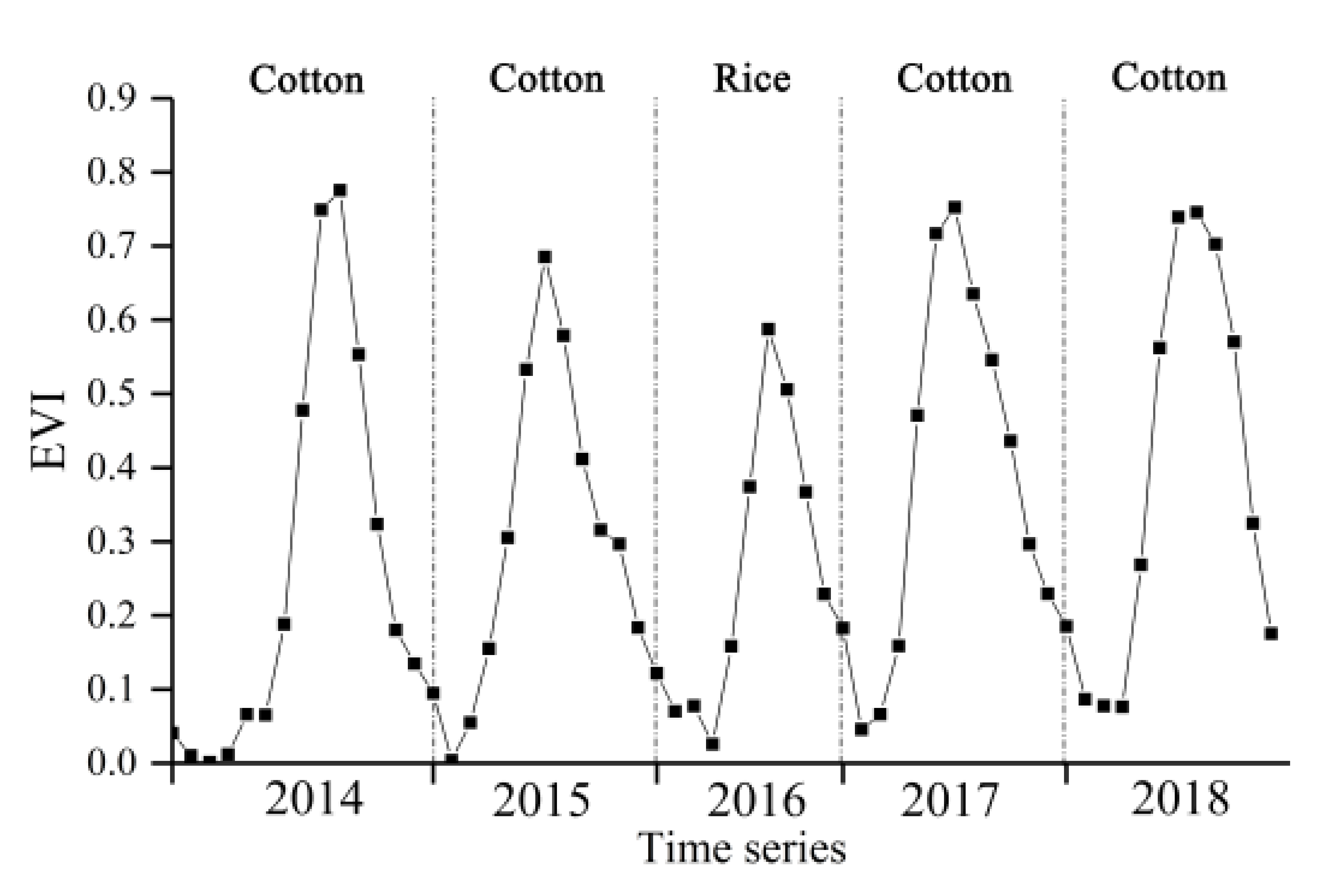 | ||
 |
| Categories | Training Samples | Validation Samples |
|---|---|---|
| Abandonment | 157 | 365 |
| Reclamation | 130 | 301 |
| Monoculture | 138 | 320 |
| Fallow | 95 | 220 |
| Rotation in 2014 | 33 | 74 |
| Rotation in 2015 | 76 | 175 |
| Rotation in 2016 | 155 | 360 |
| Rotation in 2017 | 146 | 339 |
| Rotation in 2018 | 124 | 289 |
| Others | 239 | 557 |
| Total | 1293 | 3000 |
| UA/PA (%) | OA (%) | Kappa | ||||
|---|---|---|---|---|---|---|
| Cotton | Rice | Orchard | Others | |||
| 2014 | 98.32/99.57 | 100.00/98.65 | 97.37/99.57 | 99.03/97.84 | 98.58 | 0.98 |
| 2015 | 98.53/98.90 | 96.43/98.90 | 99.44/94.65 | 96.98/98.90 | 98.16 | 0.97 |
| 2016 | 98.95/97.25 | 98.63/99.72 | 96.79/94.76 | 96.80/97.92 | 97.8 | 0.97 |
| 2017 | 97.57/92.74 | 94.38/99.12 | 96.74/91.28 | 95.07/97.12 | 95.69 | 0.94 |
| 2018 | 95.13/96.70 | 97.25/97.92 | 98.41/95.38 | 97.12/96.88 | 96.84 | 0.96 |
| Class | UA/PA (%) | Class | UA/PA (%) |
|---|---|---|---|
| Abandonment | 100.00/97.53 | Rotation in 2014 | 93.33/94.59 |
| Fallow | 100.00/98.64 | Rotation in 2015 | 100.00/94.86 |
| Monoculture | 98.38/95.00 | Rotation in 2016 | 99.44/98.89 |
| Reclamation | 97.95/95.02 | Rotation in 2017 | 99.09/96.17 |
| Other | 90.41/99.82 | Rotation in 2018 | 95.76/93.77 |
| OA (%) | 96.93 | ||
| Kappa | 0.97 | ||
| Class | UA/PA (%) | Class | UA/PA (%) |
|---|---|---|---|
| Abandonment | 99.72/98.08 | Rotation in 2014 | 83.15/100.00 |
| Fallow | 85.94/100.00 | Rotation in 2015 | 100.00/99.43 |
| Monoculture | 98.44/49.69 | Rotation in 2016 | 100.00/94.44 |
| Reclamation | 96.78/100.00 | Rotation in 2017 | 100.00/94.10 |
| Other | 97.01/98.57 | Rotation in 2018 | 100.00/90.07 |
| OA (%) | 87.8 | ||
| Kappa | 0.86 | ||
Publisher’s Note: MDPI stays neutral with regard to jurisdictional claims in published maps and institutional affiliations. |
© 2021 by the authors. Licensee MDPI, Basel, Switzerland. This article is an open access article distributed under the terms and conditions of the Creative Commons Attribution (CC BY) license (https://creativecommons.org/licenses/by/4.0/).
Share and Cite
Li, Q.; Liu, G.; Chen, W. Toward a Simple and Generic Approach for Identifying Multi-Year Cotton Cropping Patterns Using Landsat and Sentinel-2 Time Series. Remote Sens. 2021, 13, 5183. https://doi.org/10.3390/rs13245183
Li Q, Liu G, Chen W. Toward a Simple and Generic Approach for Identifying Multi-Year Cotton Cropping Patterns Using Landsat and Sentinel-2 Time Series. Remote Sensing. 2021; 13(24):5183. https://doi.org/10.3390/rs13245183
Chicago/Turabian StyleLi, Qiqi, Guilin Liu, and Weijia Chen. 2021. "Toward a Simple and Generic Approach for Identifying Multi-Year Cotton Cropping Patterns Using Landsat and Sentinel-2 Time Series" Remote Sensing 13, no. 24: 5183. https://doi.org/10.3390/rs13245183
APA StyleLi, Q., Liu, G., & Chen, W. (2021). Toward a Simple and Generic Approach for Identifying Multi-Year Cotton Cropping Patterns Using Landsat and Sentinel-2 Time Series. Remote Sensing, 13(24), 5183. https://doi.org/10.3390/rs13245183







